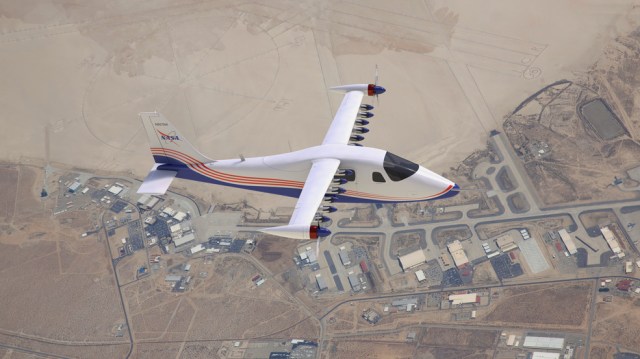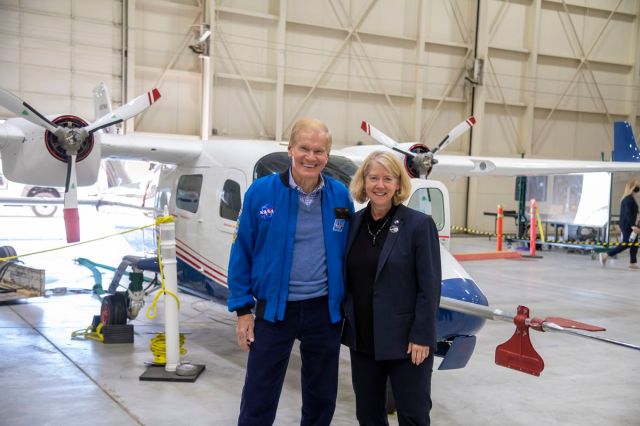NASA’s tiny electrical aircraft is almost ready for lift-off
NASA’s first electric plane is getting ready for takeoff.
For the last five years, a small team of NASA engineers has been working to convert an Italian Tecnam P2006T aircraft so that it runs only on battery power. The X-57 Maxwell, named after 19th-century Scottish physicist James Clerk Maxwell, recently began high-voltage functional ground testing at the Armstrong Flight Research Center in Edwards, Calif., and is set to take its inaugural flight in the spring of 2022.
That flight, when it happens, will signal a crucial milestone for NASA, which has been tasked by President Joe Biden to focus more of its resources on lessening the impact of climate change.
NASA Administrator Bill Nelson toured Armstrong last week, where he got an up-close look at the tiny two-seater aircraft. In an interview with The Verge, Nelson said that the technology that underpins the X-57 will be crucial in the effort to decarbonize the aviation industry.
“They’re getting ready to fly this,” Nelson said. “And it is the first demonstrator of an all-electric [airplane].”
In concept form, the X-57 has a unique look. (Wired called it “goofy as hell” back in 2016.) The high-aspect-ratio wings are much skinnier than typical airplane wings, lined with 12 electric motors with propellers to help with lift and two larger engines at the end to aid cruising. When not in use, the 12 smaller motors fold in to help reduce drag. NASA expects the X-57 will have a range of roughly 100 miles and a cruise speed of 172 mph. It will also have a maximum flight time of approximately 40 minutes.
But in reality, the motors have yet to be installed, and the X-57 still looks like a normal light aircraft that you might see at any airfield. Nelson said the prototype will soon “morph” into the image of the plane that NASA first revealed back in 2016. And from there, the team will build a hybrid version that can run on both electricity and gas.
“All of which has the purpose of lessening our reliance on fossil fuels, less pollution, and keeping the cost reasonable,” he said.

One of the main obstacles standing in the way of electric aviation is the weight of the battery. Energy density — the amount of energy stored in a battery — is the key metric, and today’s batteries don’t contain enough energy to get most planes off the ground and sustain flight beyond more than a few hundred miles. To weigh it out: jet fuel doles out about 43 times more energy than a battery that’s just as heavy.
The X-57 requires about 800 pounds of battery for its research flights, said Sean Clark, principal investigator at Armstrong Flight Research Center. One of the innovations developed by the X-57 team was an installation pack that can absorb a failed battery cell after its energy is spent, which helps prevent the failure of an entire battery pack. This experimental installation pack is already being commercialized and used by NASA’s contractors. “You have to be prepared for failures,” Clark said.
Most companies working on electric aircraft say their prototypes will be useful for short trips within a city, like from Lower Manhattan to JFK Airport. Nelson said these air taxis could prove useful in reducing the amount of surface congestion on urban roadways.
“You could have short-hop aircraft … between cities that are not far apart,” he said. “However, you could even have intracity in a large city like Los Angeles, going from one part of Los Angeles, taking passengers to another, and avoid having to get in the four o’clock traffic jam on the freeways.”
The aviation industry only produces about 2 percent of global carbon emissions. But the effort to remove the noise and pollution from flying is (pardon the pun) really taking off in a variety of ways. Figuring out how to swap jet fuel with heavy lithium-ion batteries has been a huge sticking point — one that NASA’s team of scientists and engineers feel well suited to solve.

“Are we gonna be serious about trying to save the planet?” Nelson said. “There are a lot of other things that pollute a lot more, namely coal-fired electrical plants. But the fact is we’ve got to work on them all.”
Clark said that NASA has already made huge advances in battery technology that will help the aircraft achieve lift and sustain a cruising altitude. The X-57 team’s development of battery technology, along with the packaging of energy storage into the fuselage putting the motors, has been valuable, along with figuring out a process for performing “health checks” on the battery and motors while in flight, Clark said.
Those details are being published and shared with the aviation community to help inform their own efforts. “Even before the first flight, we’re able to help support this new industry and kickstart this new technology,” Clark said.
It’s still early days for electric aircraft, but the companies developing prototypes have already conducted their own test flights. NASA wants it to be a two-way street: you share data with us, and we’ll share our learnings, too.
Last month, NASA kicked off test flights of electric vertical takeoff and landing (eVTOL) aircraft with Joby Aviation, the Northern California company that recently went public. The agency is closely monitoring the aircraft’s sound profile to see how well it compares to helicopters and other gas-powered vehicles. A major selling point for eVTOL companies is that these aircraft are noticeably less noisy than helicopters and therefore better suited for flights over populated areas.
The test flights are part of a national campaign by NASA to observe these experimental aircraft in action and gather data. Joby, which was founded in 2009, is the first eVTOL company to participate in NASA’s Advanced Air Mobility (AAM) National Campaign.
NASA is getting data from Joby, and in exchange, the company has supplied components to the X-57 project, such as its electric motors, Clark said. If this collaboration continues to bear fruit, people may find themselves whisking through in an electric aircraft sooner than they think.
“It’s really important that we support the industry and make this technology accessible to Joby and other airframe manufacturers,” Clark said, “to make these aircraft more accessible to the flying public.”
NASA’s first electric plane is getting ready for takeoff. For the last five years, a small team of NASA engineers has been working to convert an Italian Tecnam P2006T aircraft so that it runs only on battery power. The X-57 Maxwell, named after 19th-century Scottish physicist James Clerk Maxwell, recently…
Recent Posts
- Rabbit shows off the AI agent it should have launched with
- Instagram wants you to do more with DMs than just slide into someone else’s
- HPE launches slew of Xeon-based Proliant servers which claim to be impervious to quantum computing threats
- There’s No Longer a Sub-$500 iPhone. Does It Matter?
- Limited Run says potentially damaging NES carts are supplier’s fault
Archives
- February 2025
- January 2025
- December 2024
- November 2024
- October 2024
- September 2024
- August 2024
- July 2024
- June 2024
- May 2024
- April 2024
- March 2024
- February 2024
- January 2024
- December 2023
- November 2023
- October 2023
- September 2023
- August 2023
- July 2023
- June 2023
- May 2023
- April 2023
- March 2023
- February 2023
- January 2023
- December 2022
- November 2022
- October 2022
- September 2022
- August 2022
- July 2022
- June 2022
- May 2022
- April 2022
- March 2022
- February 2022
- January 2022
- December 2021
- November 2021
- October 2021
- September 2021
- August 2021
- July 2021
- June 2021
- May 2021
- April 2021
- March 2021
- February 2021
- January 2021
- December 2020
- November 2020
- October 2020
- September 2020
- August 2020
- July 2020
- June 2020
- May 2020
- April 2020
- March 2020
- February 2020
- January 2020
- December 2019
- November 2019
- September 2018
- October 2017
- December 2011
- August 2010